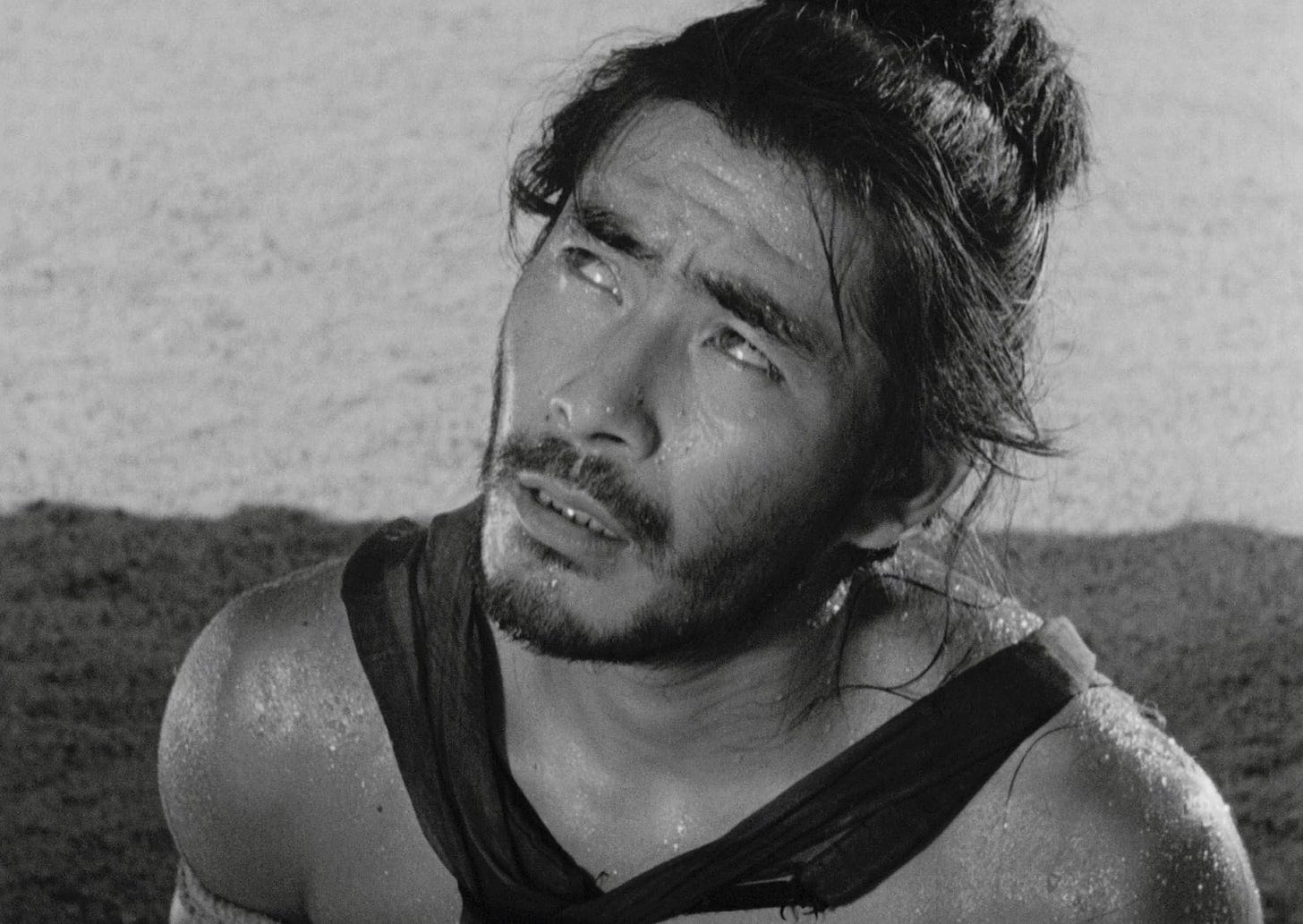Toshiro Mifune in 'Rashomon' (1950, dir. Akira Kurosawa)
An actor lets loose, and a star is born
Toshiro Mifune - at least at the start of his career - was not a technically skilled actor. I don’t mean this as criticism - I’m a sworn acolyte, and in many respects it’s his unpolished quality which makes his early performances so exciting. It’s not that he is not compelling or believable on-screen in films like Drunken Angel (1948), rather that he is very obviously untrained. He speaks too loudly, regularly maxing the mic out so that the sound warps and distorts. He moves too fast and too frequently, not yet acquainted with the notion of stillness as a vital weapon in an actor’s arsenal. And he emotes too much, in stark contrast to perennial Kurosawa favourites like Takashi Shimura. But the overall effect of this ‘too much-ness’ is remarkable. Kurosawa loved Mifune’s speed and intuition as a performer, and it was with Rashomon that the rest of the world caught on.
Rashomon is a deeply unsubtle film featuring severely intensely theatrical performances, but none as unhinged as Mifune’s. He does not chew scenery so much as he devours it, and with palpable glee. It’s a performance so feverishly, frantically amped up that one can practically hear the slick roll of his eyes in his head as he leers and gurns, excessively handsome features (that ‘too much-ness’ strikes again) twisting beyond recognition. It’s a performance that I could understand a modern viewer being more than a little baffled by - I’ve seen some claim that it’s a turn inspired by traditional Japanese theatre, but there doesn’t appear to be much truth in this. Kabuki, it’s true, features elements of stylised acting, but though the performances in kabuki can indeed be ‘big,’ they remain strictly controlled. Mifune’s comportment in Rashomon was as striking for Japanese audiences as it was for westerners. It was precisely because he was so different to other Japanese performers that Kurosawa was so besotted with him:
“Mifune had a kind of talent I had never encountered before in the Japanese film world. It was, above all, the speed with which he expressed himself that was astounding. The ordinary Japanese actor might need ten feet of film to get across an impression; Mifune needed only three.”
It’s undeniable that Mifune was a solipsistic actor - one frequently gets the impression that he’s performing in an entirely different film to his co-stars. But he expresses himself so boldly and forcefully that even when he isn’t necessarily ‘good’ (he overeggs it in a film like 1951’s The Idiot) he remains compulsively watchable. He would develop a sense of subtlety and nuance as his career progressed, but in Rashomon he lacks any and all sense of precision - it’s a performance based entirely on intuition, and in the context of the film, it works. The sense of a certain theatrical remove when it comes to the bandit Tajomaru is what Rashomon demands. The film’s three leads are required to deliver the acting equivalent of a matryoshka doll: performances inside performances inside performances. Before the unseen jury, Tajomaru is a puffed up braggart. In his own retelling, he’s a charismatic, Robin Hood style outlaw. In the wife’s version, an irredeemable rapist. The husband’s, an ultimately strangely honourable man’s man. And in the woodcutter’s final - and perhaps definitive - retelling, he’s a coward. It’s this last aspect of the performance which is, in my eyes, the most striking. Mifune is just as broad here as he is throughout, but in finally letting actress Machiko Kyo loose, Kurosawa throws a performer into the scene who is just as combative as Mifune; the results are startling. In the face of Kyo’s fury, the more ostentatious elements of Mifune’s performance are transfigured. Abruptly, Tajomaru reads as more akin to a surly, frightened child than any legendary bandit. Always a performer with an unparalleled understanding of his body, the agonising final showdown in Rashomon (which lasts almost seven minutes) is a remarkable showcase for Mifune’s speed and intelligence as an actor. He absolutely hurls himself around the grove where much of the film takes place, rolling and tumbling and falling over himself, driven nigh hysterical with fear and adrenaline. It’s a grasping, desperate, intensely physical performance, achieved by a simple redirection of the manic, animalistic energy which Mifune channels into the roaring laughter and cocky swagger of the film’s first half.
British director John Boorman, who worked with Mifune on 1968’s Hell in the Pacific, met Kurosawa some years after the film’s release and lamented how difficult it was to get Mifune to play scenes the way Boorman envisioned them. According to Boorman, Kurosawa replied:
“Impossible to direct Mifune. All you can do is point him like a missile.”
This sense of unstoppable force is present as early as his screen debut in Senkichi Taniguchi’s Snow Trail (1947), but it was with Rashomon that Mifune as we know him burst forth from the screen, wild and dynamic and vital. Under Kurosawa’s guidance, Toshiro Mifune let loose - and once the genie was out of the bottle, it was never put back.




